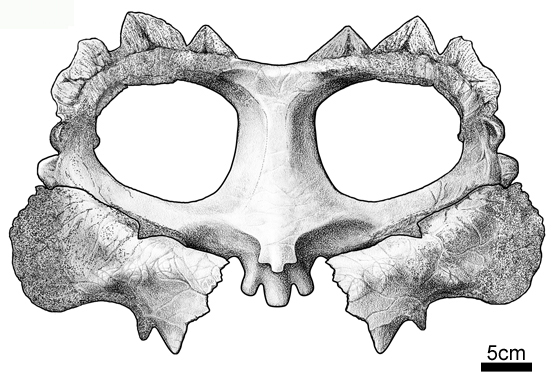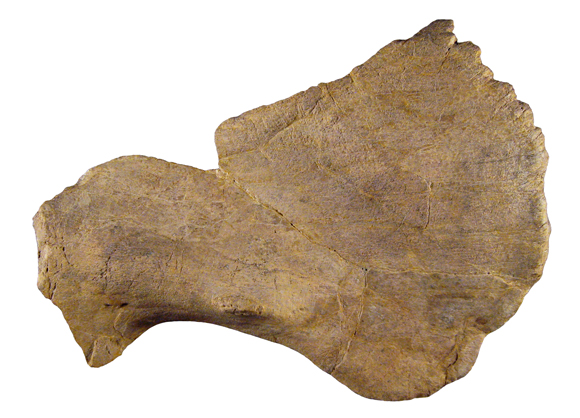Crittendenceratops krzyzanowskii – A New Horned Dinosaur from Arizona
Many scientists and observers have described the last two decades as the “Golden Age” of dinosaur discoveries. Since the turn of the century, there have been some astonishing fossil finds and many new species of dinosaur have been discovered and described. None more so than with the horned dinosaurs and their relatives (Marginocephalia).
Over the last few years, we have reported on numerous new types of ceratopsian, many of these new horned dinosaurs having been discovered in strata laid down in the United States, for example, Medusaceratops, Aquilops, Kosmoceratops and Utahceratops. Surprisingly, there had been no new horned dinosaurs named in 2018, that is no longer the case with a scientific paper published describing a new centrosaurine dinosaur from the Late Cretaceous of Arizona – Crittendenceratops krzyzanowskii.
A Life Reconstruction of the Newly Described Ceratopsian Crittendenceratops krzyzanowskii
Picture credit: Sergey Krasovskiy
Only a Few Dinosaurs Named from Arizona
Writing in the New Mexico Museum of Natural History and Science Bulletin, the researchers, Sebastian G. Dalman and Asher Lichtig, both Research Associates at the New Mexico Museum of Natural History and Science, in collaboration with John-Paul Hodnett from the Maryland-National Capital Parks Commission and Spencer G. Lucas (a curator at the New Mexico Museum of Natural History and Science), describe Crittendenceratops and assign it the Centrosaurinae subfamily of horned dinosaurs and specifically to the Nasutoceratopsini tribe.
There have been so many new horned dinosaurs from North America named and described in the last twenty years or so, that this has led to a revision of ceratopsian taxonomy. For example, the Nasutoceratopsini was erected recently (2016).
To read an article that summarises this revision: Redefining the Horned Dinosaurs.
Despite the wealth of dinosaur fossil material associated with the western United States, Crittendenceratops is one of only a handful of dinosaurs named from Arizona.
A Reconstruction of the Parietosquamosal Frill of C. krzyzanowskii

Picture credit: New Mexico Museum of Natural History and Science
Crittendenceratops krzyzanowskii from the Fort Crittenden Formation
This new herbivore has been described from fragmentary fossil material, including skull elements from the shale member of the Fort Crittenden Formation. Two individual animals are represented by the fossils. Crittendenceratops is estimated to have been around 3.5 metres in length and would have weighed about 750 kilograms. It lived 73 million years ago (Campanian stage of the Cretaceous) and the rocks that yielded the bones were deposited along the margins of a large lake that was present in an area southeast of Tucson, Arizona.
The Nearly Complete Left Squamosal (Skull Bone) of Crittendenceratops
Picture credit: New Mexico Museum of Natural History and Science
Honouring Stan Krzyzanowski
The new species was named by Sebastian G. Dalman, John-Paul Hodnett, Asher Lichtig and Spencer G. Lucas. The genus name reflects the rock formation where the fossils were found (Fort Crittenden Formation), whereas the trivial name honours the late Stan Krzyzanowski, a Research Associate from the New Mexico Museum of Natural History and Science, who discovered the first bones to be ascribed to this new dinosaur in the Adobe Canyon area eighteen years ago. Crittendenceratops can be distinguished from other members of the Centrosaurinae subfamily by the unique shape of the bones in its frill.
The scientific paper: “A New Ceratopsid Dinosaur (Centrosaurinae Nasutoceratopsini) from the Fort Crittenden Formation Upper Cretaceous (Campanian) of Arizona” by Spencer G. Lucas, Sebastian Dalman, Asher Lichtig and John-Paul Michael Hodnett published in the New Mexico Museum of Natural History and Science Bulletin.
Everything Dinosaur acknowledges the assistance of a press release from the New Mexico Museum of Natural History and Science in the compilation of this article.
Visit the award-winning Everything Dinosaur website: Everything Dinosaur.








Leave A Comment